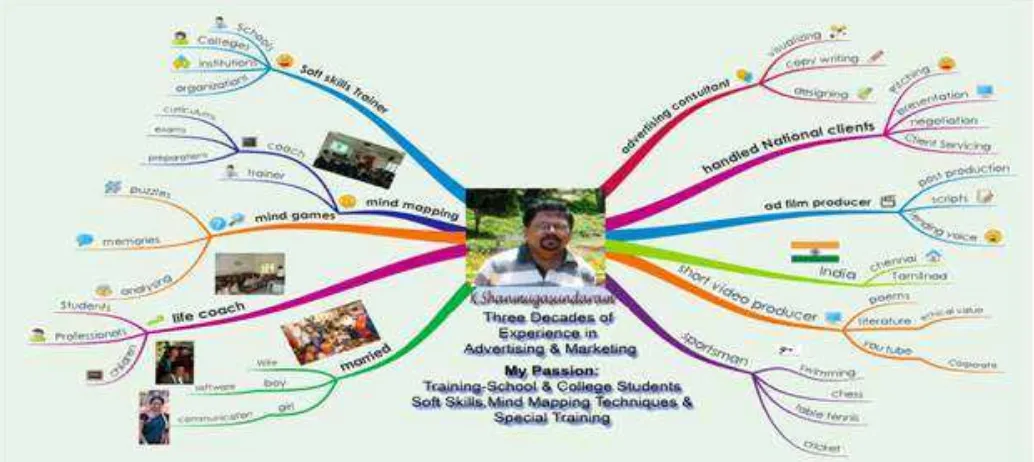Commentary
05 THE SCITECH JOURNAL VOL. 01 ISSUE 03 MARCH 2014
Mind Mapping - Cognitive Principles for Optimizing
Learning Process
K. Shanmugasundaram
Introduction
“Success in Education comes with a combination of many different elements that should be ne tuned to focus on a specic way.”
Our mind mapping methodology has been developed with the intention of learners to utilize their imagination, natural curiosity and logical thinking powers. It stimulates creativity and formulates practical and realistic solutions to complex study materials. It provides practical tools, to “be the best you can be”. In our mind mapping methods, the brain is stimulated with colors, images, connections and seamless patterns that form natural associations between concepts and idea. This will help in naturally improving one's levels of focus with enhanced speed of learning and recall. This is due to the fact that the human learning is best when it is fun, creative, colorful and invigorating.
Mind mapping involves a little bit of cognitive therapy, but does not require artistic abilities. Willingness to engage in following simple and practical methodology is the primary requirement. A Mind Map uses words, lines, codes, logics, images, colours and even sounds to stimulate
the brain. It has four important characteristics: 1.The subject is represented by a central image
2.The main themes of the subject radiate from the central image as branches.
3.Minor themes are linked to the main theme.
4.All the branches are connected forming a nodal structure.
One can always have new associations, links and connections to develop visualization skills for longer memorization. The key element is centrally located from which the links and associations radiate.
Our Mind Mapping Teaching Strategy: In 1949, Donald Hebb, a Canadian neuropsychologist, wrote what has become known as Hebb's axiomatic: “Neurons that re together wire together.” Based on this, we created Mind Mapping Tools for successful learning, on the cognitive principles for optimizing learning. We follow the methods of Mind Mapping Techniques by Tony Buzan, who is the inventor of latest
THE SCITECH JOURNAL ISSN 2347-7318
SAMANTHIArtworkshop, Perumbakkam, Chennai – 600100, Tamil Nadu, India E mail: [email protected].
Commentary
06 THE SCITECH JOURNAL VOL. 01 ISSUE 03 MARCH 2014 technology in mind mapping. We re-worked and formulated our own
methodology for teaching mind mapping to the students, in accordance to the curriculum and the grade of students, as an effective learning tool. Our teaching method is easy-to-learn, easy-to-use, and engages the students in the process of learning, as an active process.
Every brain is wired differently: The modied method as how we could arrive has the exibility and adaptability to be customized. Through our method, an art experienced student can do the mind mapping in a more artistic way. A technical mind student can do it in a graphical way. An ordinary/average student can make it in a way it's interesting to him/her. We believe in understanding the student's awareness of their level of comprehending the subjects. So, our mind mapping methodology is “How to get the most out of studies in your own way”.
The process: Like most memory enhancement systems, our method works with meaningful associations, links and connections. With just a little bit of experience, the students assimilate the concepts and components of an area of study using mind mapping. Such assimilated knowledge tends to remain fresh in their minds for many days, weeks or even more. Mind mapping utilizes the power of attention. When one pays attention to a study material deeply through mind mapping, one makes a synaptic connection through the thought process. This makes one comprehend the subject thoroughly, and it stays in the memory longer.
The Benets of Mind Mapping: 1.Creates the intention and desire to learn
2.Helps in deep and appropriate processing of critical subjects 3.Learning in an one's own way, matching an individual learning style 4.Minimizes distractions and maximizes focus
5.Makes one think and explore further ideas while studying 6.Practicing retrieval of information and application
Conclusion: Mind mapping can be successfully used for setting of goals, both short term and long term. The goals can be linked through reviewing the progress towards implementation of the goals. Mind mapping can be effective for goal-setting and to monitor the progress of actions taken towards achieving the goals. Mind mapping skills can be used for preparing effective presentations, bio-data, and enhanced public speaking skills in a creative and easy manner. Mind mapping uses the brain's imagination, natural curiosity and logical thinking powers. It stimulates creativity and formulates practical and realistic solutions to complex study materials. It provides practical tools, to “be the best you can be”.
THE SCITECH JOURNAL ISSN 2347-7318
Figure 2. Example 2 of mind maps as developed by the author
Citation: Shanmugasundaram K.2014, Mind Mapping - Cognitive Principles for Optimizing Learning Process.

